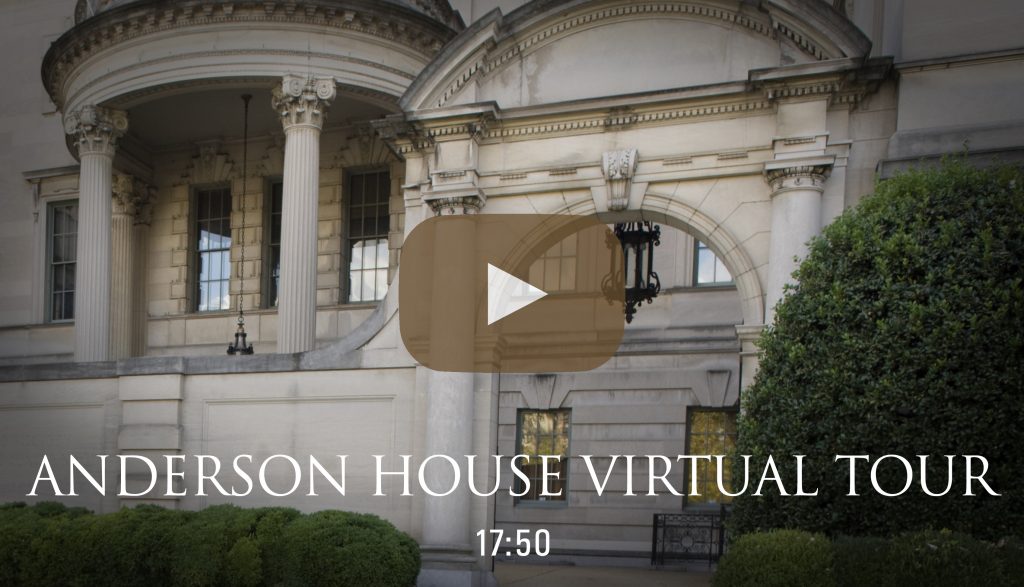
This video tour of Anderson House provides an introduction to the building’s history as well as its modern purpose as the headquarters of the American Revolution Institute of the Society of the Cincinnati.
The headquarters of the American Revolution Institute is at Anderson House, one of the finest mansions in the nation’s capital. It was completed in 1905 as the winter residence of Larz and Isabel Anderson, who used the the house as a showcase for their art collection, a backdrop for entertaining and a setting for diplomatic, patriotic and philanthropic events. Larz Anderson was a devoted member of the Society of the Cincinnati. After his death in 1937, Isabel Anderson presented Anderson House to the Society of the Cincinnati to serve as its national headquarters and museum. In 1938, an act of Congress declared Anderson House a “national museum for the custody and preservation of historical documents, relics, and archives, especially those pertaining to the American Revolution.”
The Society of the Cincinnati opened Anderson House to the public in 1939, but it took many years for a national institution dedicated to the American Revolution to take shape. The Society’s archives—an invaluable resource for the study of the American Revolution and its aftermath—remained in the safekeeping of the Library of Congress until a library vault and a reading room could be constructed at Anderson House. In the interim, the Society began accumulating art and artifacts of the American Revolution, most of them donated by members of the Society of the Cincinnati. Many of these gifts were heirlooms of the Revolutionary War and the earliest years of our republic. Others, like a selection of Revolutionary War armaments presented by John S. du Mont, were given to the Society by discerning collectors. Today the collections continue to grow through the generosity of patriotic Americans who embrace our mission to promote understanding and appreciation of the American Revolution and its legacy.
With support from the estate of Harold Leonard Stuart, the Society constructed a research library on the lower level of Anderson House in 1971 and opened its archives for research in 1973. A few years later, an anonymous donor endowed a major lecture series on the American Revolution—the George Rogers Clark Lectures—which have been held at Anderson House every year since 1975. The first Clark Lecture was delivered by Samuel Eliot Morison. The series has since featured many of the most distinguished historians of the American Revolution. With support from the family of H. Bartholomew Cox, the Society began awarding the Society of the Cincinnati Prize, recognizing outstanding work on the American Revolution. With the help of several donors, the Society began accumulating rare and modern books to support scholarly research on the American Revolution, culminating in 1988 with the establishment of the Robert Charles Lawrence Fergusson Collection on the art of war in the age of the American Revolution, which has grown to become one of the world’s most important collections of books, manuscripts, pamphlets, broadsides, maps and prints related to the military dimensions of the American Revolution.
By the 1990s the Society’s collections had outgrown the existing research library and the rooms available for storage and exhibition of its museum collections on the Revolutionary War. The Society then undertook a major renovation, creating the modern research library as well as professional museum facilities. In recognition of its increasing importance as a cultural resource, the National Park Service designated Anderson House a National Historic Landmark in 1996.
The renovation of Anderson House opened up the potential for expanded public programs to promote understanding and appreciation of the American Revolution. In 2004 the Society reorganized its staff and placed the management of its headquarters in the hands of an historian of the American Revolution with the charge to use the Society’s resources to fulfill the ambition of the Society’s founders: to perpetuate the memory and ideals of the American Revolution. The Society began to mount increasingly ambitious museum exhibitions on the Revolution and its legacy, launched a still-expanding array of public lectures and events, instituted research fellowships to bring rising scholars to conduct research in the library, and increased its efforts to enrich education on the Revolution.
This expansion led to the creation of the American Revolution Institute in 2012. We welcome all Americans to join the Associates of the American Revolution Institute and to visit the headquarters of the American Revolution Institute—now the heart of a dynamic national organization dedicated to promoting understanding and appreciation of the most important event in American history.
Learn more about the Associates Learn More about Anderson House